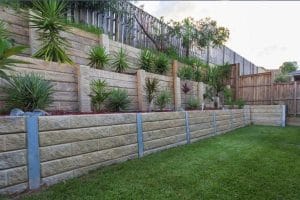Creating an Australian native garden is easy if you follow the basic landscape design principle of choosing the right plant for the right conditions. When developing a native garden design in Perth, there are options to use trees, shrubs and groundcovers that are ‘endemic’ (ie limited to a specific geographical location) or native to Western Australia, or native to Australia as a whole.
The most beautiful native landscapes are havens for birds and animals, offering shelter, food, water and year-round colour and interest. These gardens will also incorporate the use of natural materials for example timber, stone, gravels etc.
Added points of interest can be added with water bowls or bird baths, or even a naturally styled creek bed. A native garden lends itself to curved paths, with soft or transitional edges. And as in all good Landscape design the principles of unity, proportion and order etc should be followed.
NATIVE GARDEN DESIGN PERTH
As a first step in developing the best native Landscape Design for your area, you would need to determine what zone your garden falls into. Put simply, Perth can be divided into four broad zones, characterised by specific, soil, climate and water conditions. Running north/south and parallel to the coastline, these zones are listed from west to east, are listed below.
ZONE 1.
Made up of beach sands and limestone outcrops, and exposed to strong salt-laden winds, this is the western most part of the Swan Coastal Plain. eg suburbs like Cottesloe. A sustainable native landscape design in this zone will have to consider such factors as,
- development of wind breaks or shelters, either with hardscaping (eg walls, fences) or screening/hedging plants.
Native plants suitable for this zone include Coastal salt bush (Atriplex isatidea), Coast Honey myrtle, Rottnest Island Tea tree and groundcovers like the native pigface (Carpobrotus glaucescens) are also useful as they hold water in their leaves and can withstand the hot dry conditions. Further native plant choices should take into account the slightly higher pHs typical in this Zone (and Zone 2 also).
ZONE 2.
East of ZONE 1, this zone is characterised by increasing levels of poor dune sands, including what is known as Bassendean sands. Typically described as ‘gutless’ they are low in organic matter, with very poor water retention capabilities. This describes the majority of the Perth residential area, and the Swan Coastal Plain. The main considerations when developing a native landscape design in this zone include
- Increasing the water retention capabilities and organic matter content of the sandy soils
Native plants suitable for this zone include trees like Banksias and some eucalypts, shrubs like Adenanthos (woolly bush) and grassy plants like Patersonia occidentalis.
ZONE 3.
Is made up of those areas along the base of the Darling scarp and along the major Rivers and creeks coming off the range. eg Swan and Canning Rivers. These areas will have more clays and gravels, as a result of run-off and flooding downstream. For example the areas around Guildford, historically used as a source of clay for brick making. Landscaping a native garden in this zone would need to consider
- With high clay content comes issues with waterlogging and poor drainage. Adding gypsum and or organic matter can help to open out the structure of the soil
Native plants suitable for this zone include a wide range of plants but can include some of the Grevilleas, Hakeas and Dianellas. The variety is endless.
ZONE 4.
The Darling Range itself, suburbs like Roleystone, Kalamunda, Lesmurdie, where the depth of soil varies greatly. The bedrock granites, weathered to brown coffee rock boulders, can be both a feature and a hindrance when developing a garden in this zone. Unique to this area are the following landscape design considerations
- Designing for fire and frost. Although all of Perth can be subject to the threat of Bushfires, it is the areas furtherest east, intermingled with the native bush and accessed only by winding hill-side roads, that need to consider native plant choices that offer lower fire risk. This zone is also more susceptible to night time frosts during winter. The best design for Bush Fire planning will take into account the location of groundcovers, shrubs and trees, so that fuel is not built up close to houses and other buildings.
- There is also the added Landscaping complexity of greater relief, (height variations), which means that the development of a garden design in this zone may require retaining walls, and terracing. So there may be a larger proportion of design costs assigned to hardscaping elements
Native plants suited to this zone include Marri and Jarrah trees, Grasstrees and shrubs and small flowering shrubs like some of the verticordias etc.
When designing a native garden landscape in Perth, it is advisable to seek out the knowledge and expertise of an experienced Landscape Designer in the first instance. You can also investigate the Wildflower Society Group local to your area, and visit specialist native nurseries, where possible. If you understand the soil and climate conditions you already have, there is always going to be a combination of plants that will thrive in those conditions. With less landscaping intervention in the way of additional soils and extra watering needs, typical of most exotic plants, a native garden is usually the most sustainable, and in the long term-cheaper option for the owner.
Need Us To Help With Your Garden?









